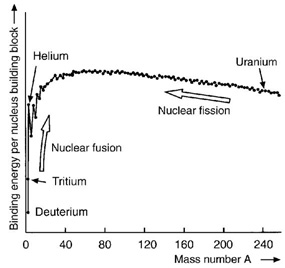Binding energy
 scroll scroll 
The energy required to separate particles which are
bound by electromagnetic or nuclear forces (infinitely far apart). In
the case of the nucleus of an atom, these particles are protons and
neutrons held together by the nuclear binding energy. The neutron and
proton binding energies are the energies necessary to release a neutron
or proton from the nucleus. Electron binding energy is the energy required
to completely remove an electron from an atom or a molecule. The binding
energy of nucleons in the nucleus of an atom amounts for most nuclei
(i.e. Z>5) to around 8 MeV per nucleon. However in the case of the
heaviest nuclei of an atom, such as uranium, the binding energy per
nucleon is slightly less negative than for nuclei with medium mass numbers.
Therefore, the fission of an uranium nucleus into two nuclei of medium
mass number results in a total more negative binding energy leading
to energy being released to the outside (See also 'nuclear
fission'). Similarly the binding energy of the light nuclei of the
hydrogen isotopes deuterium and tritium is significantly less negative
than that of the helium nucleus He-4. Thus, energy is released during
the fusion of deuterium and tritium to helium (See also 'fusion').
Diagram binding energy

Nucleus binding energy per nucleon as
a function of the mass number
back
|
|

11 - 15 March 2018
Munich, Germany

30 September - 04 October 2018
Prague, Czech Republic |